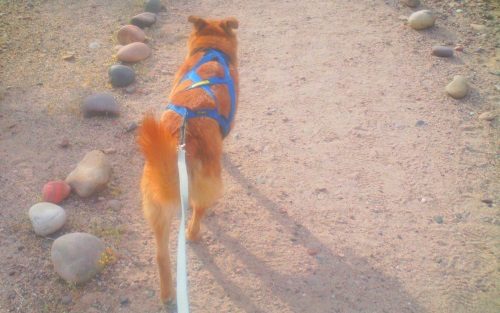Last updated: March 6, 2022. Originally published: April 8, 2013
Once upon a time, there was a dog named Jonas. Jonas drove his owner (me) crazy with his problem of pulling on the leash. Ever since he was a pup, as soon as you put him on leash he’d run to the end and pull like his life depended on it.
This was really annoying. So I worked on loose-leash training with prong collars, choke chains, and later, as I became more enlightened, front-clip harnesses and hot dogs. With a lot of patience and consistency, it mostly worked. I could now take Jonas for a walk without fear of dislocating my shoulder.
One day, I was browsing pictures of that year’s Iditarod (I’ve been a huge mushing nerd ever since I saw Balto when I was five). I came across a photo of a dog in the starting chute, lunging against his harness, tongue flying out the side of his mouth, eyes wide with excitement. This dog looked exactly like Jonas. Huh. Pretty cool.
I kept scrolling. There was another Jonas look-alike. And another.
It seems that my mystery mutt isn’t such a mystery anymore. He’s a husky mix!
Wait.
Husky. Sled dog. Pulling.
The light bulb went off.
Turns out the reason Jonas loves to pull is because that’s literally what he was bred to do.
I felt like a massive idiot at this point. See, I’d always wanted to try dryland mushing – harnessing a dog up to pull a scooter or bike. All this time, I had the perfect dog for the sport.
I don’t know why I never made the connection. I guess since Jonas was my agility dog, I mentally put him in the Agility Dog box, and it never even occurred to me that he might fit in the Urban Mushing box.
Oh well. Better late than never.
I traded in Jonas’s old no-pull harness for a mushing harness (the prong collar is hanging on my wall as a silent testament to human folly). I’m teaching him to pull a mountain bike. It can be slow going at times, because -get this- all those years of loose-leash walking training worked really well! When I encourage him to pull, he says, “wait. I’M NOT SUPPOSED TO DO THIS. Is this a trick? Are you testing me?”
But once he gets going, he really enjoys this new game.
The moral of the story: Instead of fighting with your dog’s instincts, sometimes it’s easier to develop a constructive outlet for them.
MISADVENTURE TIME! Life lessons from a cartoon
I was scrolling through the internet the other day and stumbled upon a clip from a show called Adventure Time. This clip really caught my attention:
“I’ve got a problem,” says Jake. “This dolphin fell in love with me!”
“That’s the opposite of a problem!” Finn replies. Cue wacky dolphin adventures.
That’s the opposite of a problem. Oh boy, this applies to so much of training and living with dogs!
In our relationships with our dogs, we often adopt an adversarial model. When your dog does something you don’t like, you have to stop that behavior. Make the dog obey you. Stop her from doing what you don’t want. But this approach doesn’t take into consideration the fact that often, the dog was bred to do the thing you don’t like.
I got an email from someone who was annoyed with her terrier. She was upset that her terrier kept digging up her yard.
…Yeah?
That’s kind of what they were designed for. To dig holes and kill pesky burrowing critters.
Figuring out your dog’s dream job
Last week, I wrote a post called How to Solve Practically Any Annoying Dog Behavior Problem. It’s a detailed formula for what to do when your dog is, say, digging up your yard or pulling on leash. If you’re struggling with a dog behavior issue, go check it out.
However.
You must understand: you have to give your dog something to do. She needs to work. Probably desperately, which is why she’s getting into trouble.
Not to get all preachy and annoying, but in today’s society, pet dogs are severely under-stimulated. They were designed to work with people, and they’ve pretty much lost their jobs.
Channel your terrier’s predatory instincts into lure coursing.
If your dog is hard to control in public because she’s always following her nose, you might try nose work games or tracking or hide-and-seek.
I gave my chronic leash-puller the chance, at almost ten years old, to embrace his husky heritage.
Yeah, it takes some work to give your dog a job. But isn’t the whole point of having a dog to do cool stuff with them?
If you can’t or won’t put the time and effort into some awesome canine adventures, maybe you should get a goldfish instead. Or a hamster. Or a cat (although a cat might give you a run for your money too).
To pick the right “job” for your dog, you have to be less adversarial and more cooperative. Look at your dog’s problems not as problems, but as opportunities. The opposite of problems. Your dog’s way of telling you what she wants to do.
Sometimes, they’ll tell you things you don’t want to hear. When I adopted my first dog, Friday, my plan was to turn her into an agility and frisbee dog.
Ha! She was having NONE of that. She had no time for organized sports.
She wanted to be Rin Tin Tin.
Her thing was hiking and exploring and grand adventures in the Great Outdoors. We had a lot of fun with that. It’s something I would’ve missed out on if I had insisted that she do the thing I wanted.
Behavior modification is often about getting dogs to stop acting like dogs. It’s our responsibility to let our dogs be dogs sometimes.
Give them their jobs back.
If you’re not sure what kind of activities to try, ask your dog what she wants. She’s probably been telling you all along.






